
The Short Country Nationals: SNC, SNB
This page created 22 January 2000
by Ian Smith, updated 29th January 2004. Best at 800*600.

SNB71-115: Green Line buses
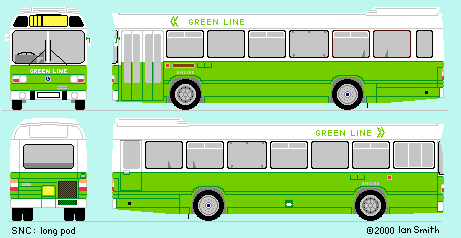 December 1973 saw the arrival of shorter Leyland Nationals, only 10.3m (34ft 4in) long,
and with a single doorway at the front. They were still fitted with bus seats,
but London Country had the pvc seats recovered in moquette
to reduce the tendency to slide hither and yon. Again most were for GreenLine use.
December 1973 saw the arrival of shorter Leyland Nationals, only 10.3m (34ft 4in) long,
and with a single doorway at the front. They were still fitted with bus seats,
but London Country had the pvc seats recovered in moquette
to reduce the tendency to slide hither and yon. Again most were for GreenLine use.
They had the original long air-conditioning pods on the roof. Delivered in green,
most were given white uppers and Green Line fleetnames before entry into service.
Initially the SN class, most were quickly reclassified as SNC (Short National Coach),
although a handful retained all-green and were classified SNB.
They made their debut on the 708, introducing the joy of National travel
to the stock-brokers of East Grinstead.
(Did this hasten electrification of the railway?).
The 719 followed in January 1974, the 714 in March.
The 712 and 713 were the April fool selection,
with the 701 following along in September. Meanwhile St.Albans introduced the bus variant on
the 313 in May 1974, using all-green SNB103 and SNB111-115 for the most part.
| Route No | Route | Garage |
|---|
| 708 | East Grinstead - London - Hemel Hempstead | EG East Grinstead
HH Hemel Hempstead |
| 719 | Hemel Hempstead - Watford - London | GR Garston
SJ Swanley |
| 714 | Dorking - Kingston - London - Kings Cross - St.Albans - Luton | DS Dorking
LS Luton |
| 712 | Dorking - Morden - London - St.Albans - Luton | DS Dorking
SA St.Albans |
| 713 | Dorking - Morden - London - St.Albans - Dunstable | DS Dorking
SA St.Albans |
| 313 | St.Albans - | SA St.Albans |
| 701 | Gravesend - London - Staines - Ascot | NF Northfleet
ST Staines |
They were an interim class, with the standard of interior design and seating acknowledged as inadequate for the Green Line.
They were quickly replaced by the next batch, and took over from RFs, Swifts and Merlins
on bus work, being redesignated SNB. They retained dual-purpose livery for some time.
Some went to Dunton Green in March 1975 to displace RFs from the 402,
while at the same time others at East Grinstead displaced RFs from the 428, 434, 435 and 473.
SNC116-202: Green Line coaches
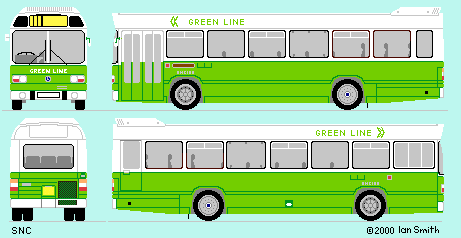 They were followed during the next couple of years by a better breed of National.
The bus companies had finally convinced Leyland that there should be
a coach-seated version of the National with an improved interior and cab,
aimed at providing a "suburban bus" rather than a purely urban people-mover.
They were followed during the next couple of years by a better breed of National.
The bus companies had finally convinced Leyland that there should be
a coach-seated version of the National with an improved interior and cab,
aimed at providing a "suburban bus" rather than a purely urban people-mover.
The first of the new 39 seaters arrived in 1974 and displaced long Nationals (LNCs)
from their Green Line routes, the LNCs being downgraded to LNB and used on busier bus routes
in place of Merlins, Swifts and Reliances. (eg the 387 at Tring).
| Route No | Route | Garage | Type displaced |
|---|
| 721 | Brentwood - Romford - London (Aldgate) | RE Romford | LNC |
| 706 | Aylesbury - London - Westerham | TG Tring | LNC |
| 711 | High Wycombe - London - Reigate | RG Reigate
HE High Wycombe | LNC |
In August 1974 new Nationals took over from RC Reliances at Grays on the 723.
Then in October 1975 the 701 was withdrawn, and its Northfleet LNCs moved to
Chelsham for its share of the 706, the Staines contingent replacing RPs on the 725.
In May 1976 they took over the last Routemaster coach operation, the commuter 709 service.
| Route No | Route | Garage | Type displaced |
|---|
| 723 | Tilbury Ferry - Rainham - London (Aldgate) | GY Grays | RC |
| 725 | Windsor - Staines - Croydon - Bromley - Dartford | ST Staines | RP |
| 706 | Aylesbury - London - Westerham | CM Chelsham | RF |
| 709 | Godstone - London | GD Godstone | RCL |
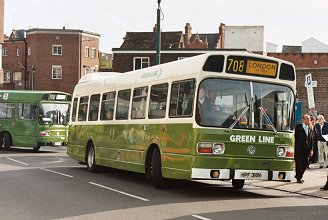 But the SNCs did not get it all their own way on GreenLine work.
The service was in the process of contraction anyway,
with competition from newly electrified suburban train services on all fronts:
the Tilbury, Bedford, and Kings Cross lines were all being upgraded,
and the Waterloo to Surrey lines were having new trains too.
Green Line patronage was not blossoming.
It was decided that perhaps the Leyland National image was not helping,
and London Country started buying real coaches,
with recognisable coach bodies by builders such as Plaxton and Duple.
After initial experience on non stage carriage work they bought more of them for the GreenLine.
The SNCs were ousted from the Greenline network, but were welcomed onto bus work,
where their coach seats were an improvement on the bus variety.
Unlike the first batch they retained their SNC designation.
But the SNCs did not get it all their own way on GreenLine work.
The service was in the process of contraction anyway,
with competition from newly electrified suburban train services on all fronts:
the Tilbury, Bedford, and Kings Cross lines were all being upgraded,
and the Waterloo to Surrey lines were having new trains too.
Green Line patronage was not blossoming.
It was decided that perhaps the Leyland National image was not helping,
and London Country started buying real coaches,
with recognisable coach bodies by builders such as Plaxton and Duple.
After initial experience on non stage carriage work they bought more of them for the GreenLine.
The SNCs were ousted from the Greenline network, but were welcomed onto bus work,
where their coach seats were an improvement on the bus variety.
Unlike the first batch they retained their SNC designation.
SNC168, immaculate in fresh Green Line green and white dual-purpose livery made
a stir when it crossed London to reach the East Grinstead Running Day in April 2003.
SNB203-227: 'phase one' buses
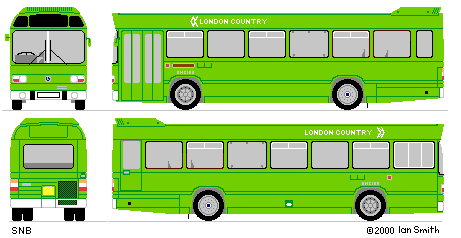 The coaches were shortly followed into service by short National buses,
the first of many. The first few were the last of the "phase one" Nationals,
before the worst of the rackety noise problems were tackled. They had bus seats,
of course, and overall unrelieved NBC green livery,
with white fleet-name and logo. Uninspiring.
The coaches were shortly followed into service by short National buses,
the first of many. The first few were the last of the "phase one" Nationals,
before the worst of the rackety noise problems were tackled. They had bus seats,
of course, and overall unrelieved NBC green livery,
with white fleet-name and logo. Uninspiring.
They went into service around the London fringes,
filling the gaps in bus rosters
caused by frail old buses and inadequate newer ones.
They gained a reputation for noisy reliability.
SNB228-375: 'phase two' buses
The National was obviously proving popular with everyone,
so London Country kept buying more.
(After all, National Bus Company HQ had issued the edict that NBC companies WOULD buy Leyland Nationals,
even if they really wanted Bristol REs - but that's another tale).
The "phase two" buses were less rackety, with some of the rattles designed out.
They continued the job of ousting all the other single deckers in London Country's fleet,
other than the small Bristols that could get into the tight corners where Nationals feared to tread.
They ousted a lot of double-deckers too,
and helped to eliminate the Routemasters from the country fleet.
(These went off to a desperate London Buses, who couldn't make anything else work).
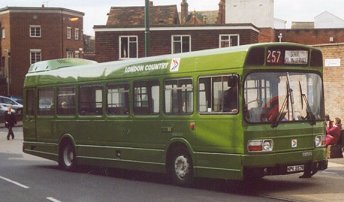
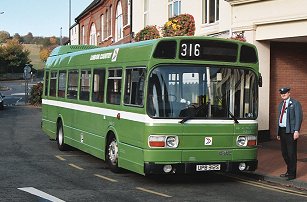
SNB 257 has been repainted from Northumbria's dazzle scheme into plain NBC green,
and is seen making an appearance at East Grinstead Running Day in April 2001.
SNB312 shows the "relaxed" NBC livery, allowing a white band, which greatly improved the visibility of the buses as well as arguably improving their looks.
Eddie Knorn poses beside his bus at Chesham Broadway in October 2003.
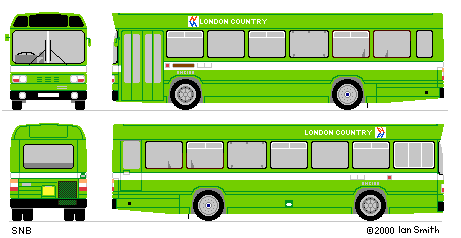
SNB378-543: Series B buses
Series B were more basic. They came without the air- conditioning pod,
but with conventional floor-mounted saloon heating.
Small ventilation grilles appeared on the front,
and the bumpers now came in black instead of white.
Under the back was the standard Leyland 510 engine, derated for longer life.
They were a lot cheaper. London Country bought 166 of them,
to complete their fleet modernisation.
They dared send these cheap ones down lanes previously thought suitable only for the little Bristols,
and soon the BNs and BLs were disappearing from the fleet too.
Partition and Privatisation
 The Nationals became invisible.
London Country - and the rest of the country -
had so many of them that people stopped noticing them.
And photographing them.
They were "just a bus".
They took London Country into the eighties,
and rumbled and rattled away around the rural rim.
(Nice bit of onamatopeiac alliteration - did you notice?)
The Nationals became invisible.
London Country - and the rest of the country -
had so many of them that people stopped noticing them.
And photographing them.
They were "just a bus".
They took London Country into the eighties,
and rumbled and rattled away around the rural rim.
(Nice bit of onamatopeiac alliteration - did you notice?)
As that desperate decade drew on,
with anything labelled "public" placed in the pillory and starved of capital,
investment in buses dwindled. The Nationals soldiered on.
The British bus manufacturing industry just about died.
The National Bus Company was to be broken up into small competitive units,
which meant that even London Country was considered too large.
(Its bus stock went into three figures).
So it was broken into four separate companies: imaginatively named London Country North West,
London Country South West, London Country South East and London Country North East.
Preserved SNB312 at East Grinstead in April 2001,
having worked in from Hemel Hempstead.
All the four companies were sold early in 1988,
and entered the peculiarly unstable world of takeovers,
tendering, and taxidermy.
A few people made a lot of money. It was not the crews.
The companies changed hands, were divided, combined and redivided,
and the bus stock, Nationals included, went round with it.
Presently the minnow companies were swallowed by larger ones,
which were in turn ingested by yet larger ones,
until most of the London Country area had bus companies owned by a single owner again:
the Cowie group, otherwise known as Arriva.
LCSE: Kentish Bus
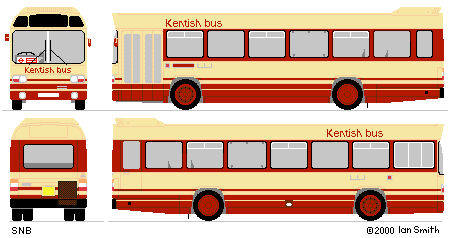 South East promptly renamed itself Kentish Bus, and began an image boost,
with a new livery of cream and maroon. The company had forty SNB Nationals,
plus a long trainer,
and a small number of LS/LSL Nationals allocated by London Regional Transport
for use on the Croydon Mobility Network.
The SNB buses lost their fleet-numbers, becoming simply 437 - 486.
Some of them were used on the traditional routes of the old Country Area,
although these soon lost their traditional route numbers,
until protests from an indignant and very conservative local populace
forced a return to traditional numbers on routes like the 402.
They also appeared on tendered routes, including the 227 until replaced by Greenways.
A sizeable number was transferred to sister company Northumbria.
South East promptly renamed itself Kentish Bus, and began an image boost,
with a new livery of cream and maroon. The company had forty SNB Nationals,
plus a long trainer,
and a small number of LS/LSL Nationals allocated by London Regional Transport
for use on the Croydon Mobility Network.
The SNB buses lost their fleet-numbers, becoming simply 437 - 486.
Some of them were used on the traditional routes of the old Country Area,
although these soon lost their traditional route numbers,
until protests from an indignant and very conservative local populace
forced a return to traditional numbers on routes like the 402.
They also appeared on tendered routes, including the 227 until replaced by Greenways.
A sizeable number was transferred to sister company Northumbria.
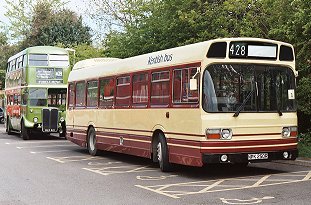

SNB 250, seen below in apple-green,
has now been repainted into the attractive Kentish Bus livery of maroon and primrose.
With Kentish Bus fleetnames freshly applied to the cant-rails, it is seen at East Grinstead Running Day in April 2003..
LCNW
London Country North-West retained its name until swallowed by Luton & District in late 1990.
It settled on a sombre livery of dark green with silver-grey and diagonal go-faster markings.
Not surprisingly, perhaps, this fleet of Nationals had a very high proportion of bright over-all advertisements!
After the takeover they retained the livery, but with Luton & District fleetnames, and were fairly early candidates for replacement.
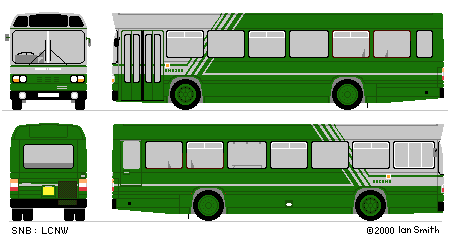
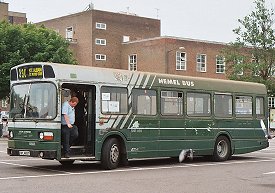
Preserved SNB469 helped out on the shuttle between Hitchin and Stevenage during the 1993 Running Day,
still wearing its LCNW livery and Hemel Bus fleetnames.

LCNE: Sovereign and County
London Country North East was bought by AJS and Parkdale in April 1988,
then divided into two chunks in January 1989.
Sovereign Bus and Coach was based at Hatfield and Stevenage,
while County Bus nd Coach was at Hertford, Harlow and Grays.
 Sovereign operated under the Hertsrider name at Hatfield, with some vehicles outstationed at St.Albans and Luton.
The Nationals were in pale blue and cream. Hatfield garage closed, and a rival, Welwyn-Hatfield Line, arose,
but was taken over in 1990. Two of the Sovereign Nationals then received the coffee and chocolate livery.
Sovereign operated under the Hertsrider name at Hatfield, with some vehicles outstationed at St.Albans and Luton.
The Nationals were in pale blue and cream. Hatfield garage closed, and a rival, Welwyn-Hatfield Line, arose,
but was taken over in 1990. Two of the Sovereign Nationals then received the coffee and chocolate livery.
May 1990 saw most of the Stevenage operations taken over by Luton & District.
 County used a group livery of cream with dark green skirts and lining,
with local fleetnames: Townlink for Harlow, Lea Valley for Hertford and Thameside for Grays.
County used a group livery of cream with dark green skirts and lining,
with local fleetnames: Townlink for Harlow, Lea Valley for Hertford and Thameside for Grays.
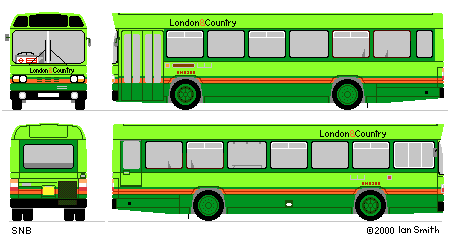
LCSW: London & Country
London Country South-West was bought by the Drawlane group, and evolved into London & Country.
They stayed faithful to the National, that looked good in their two-tone green and red livery.
Of the Nationals that stayed within the London & Country area,
some were given the Greenway treatment - but that deserves a separate page.
Others were refurbished and re-engined with a much less expensive "Urban Bus"
refit, that retained the original National look but with updated design concepts realised in it.
While all this was happening, the Nationals were getting old.
Many whirled off the merry-go-round, and found new homes in other fleets around the country.
All sorts of companies that once would never have dreamed
of buying second-, third-, or fourth-hand buses ended up with
ex-London Country Nationals. Others stayed at home.
The nineties saw many of the Nationals retire,
overtaken by a new generation of do-anything, go-anywhere single deckers,
exemplified by the Dennis Dart.
Some Nationals have reached 2000 still in service,
but not as large a proportion as of more or less contemporary Metrobuses.
Very few still exist in the outer London area,
and the ex- London Country examples that went to other large companies such as North Western
have retired, or been dispersed to smaller companies.
Who has noticed their passing?
Preservation
Late in the 1990s National preservation took off in earnest,
with examples preserved from fleets all over the country.
The London Country buses have not been forgotten,
with a growing number acquired from later owners and restored
to early liveries now appearing at events.
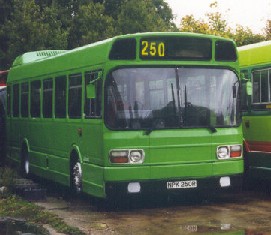

Mike Nash deals in Leyland Nationals,
with a sizeable selection for sale or in preservation at Depot 42,
near Cobham.
During the RF Running Day in October 1999 the depot was open as a running base,
and parked there were SNB250, neatly repainted in overall green;
SNB 542, ex-Keighley and District; and SNB543, ex-Hall of Kennoway.

 bus histories bus histories
 photo refs photo refs
 Ian's Bus Stop Ian's Bus Stop
 LN, LNB LN, LNB
 Nationals: London Buses Nationals: London Buses
 Greenways Greenways

|

 December 1973 saw the arrival of shorter Leyland Nationals, only 10.3m (34ft 4in) long,
and with a single doorway at the front. They were still fitted with bus seats,
but London Country had the pvc seats recovered in moquette
to reduce the tendency to slide hither and yon. Again most were for GreenLine use.
December 1973 saw the arrival of shorter Leyland Nationals, only 10.3m (34ft 4in) long,
and with a single doorway at the front. They were still fitted with bus seats,
but London Country had the pvc seats recovered in moquette
to reduce the tendency to slide hither and yon. Again most were for GreenLine use.
 They were followed during the next couple of years by a better breed of National.
The bus companies had finally convinced Leyland that there should be
a coach-seated version of the National with an improved interior and cab,
aimed at providing a "suburban bus" rather than a purely urban people-mover.
They were followed during the next couple of years by a better breed of National.
The bus companies had finally convinced Leyland that there should be
a coach-seated version of the National with an improved interior and cab,
aimed at providing a "suburban bus" rather than a purely urban people-mover.

 The coaches were shortly followed into service by short National buses,
the first of many. The first few were the last of the "phase one" Nationals,
before the worst of the rackety noise problems were tackled. They had bus seats,
of course, and overall unrelieved NBC green livery,
with white fleet-name and logo. Uninspiring.
The coaches were shortly followed into service by short National buses,
the first of many. The first few were the last of the "phase one" Nationals,
before the worst of the rackety noise problems were tackled. They had bus seats,
of course, and overall unrelieved NBC green livery,
with white fleet-name and logo. Uninspiring.




 South East promptly renamed itself Kentish Bus, and began an image boost,
with a new livery of cream and maroon. The company had forty SNB Nationals,
plus a long trainer,
and a small number of LS/LSL Nationals allocated by London Regional Transport
for use on the Croydon Mobility Network.
The SNB buses lost their fleet-numbers, becoming simply 437 - 486.
Some of them were used on the traditional routes of the old Country Area,
although these soon lost their traditional route numbers,
until protests from an indignant and very conservative local populace
forced a return to traditional numbers on routes like the 402.
They also appeared on tendered routes, including the 227 until replaced by
South East promptly renamed itself Kentish Bus, and began an image boost,
with a new livery of cream and maroon. The company had forty SNB Nationals,
plus a long trainer,
and a small number of LS/LSL Nationals allocated by London Regional Transport
for use on the Croydon Mobility Network.
The SNB buses lost their fleet-numbers, becoming simply 437 - 486.
Some of them were used on the traditional routes of the old Country Area,
although these soon lost their traditional route numbers,
until protests from an indignant and very conservative local populace
forced a return to traditional numbers on routes like the 402.
They also appeared on tendered routes, including the 227 until replaced by 




 Sovereign operated under the Hertsrider name at Hatfield, with some vehicles outstationed at St.Albans and Luton.
The Nationals were in pale blue and cream. Hatfield garage closed, and a rival, Welwyn-Hatfield Line, arose,
but was taken over in 1990. Two of the Sovereign Nationals then received the coffee and chocolate livery.
Sovereign operated under the Hertsrider name at Hatfield, with some vehicles outstationed at St.Albans and Luton.
The Nationals were in pale blue and cream. Hatfield garage closed, and a rival, Welwyn-Hatfield Line, arose,
but was taken over in 1990. Two of the Sovereign Nationals then received the coffee and chocolate livery.
 County used a group livery of cream with dark green skirts and lining,
with local fleetnames: Townlink for Harlow, Lea Valley for Hertford and Thameside for Grays.
County used a group livery of cream with dark green skirts and lining,
with local fleetnames: Townlink for Harlow, Lea Valley for Hertford and Thameside for Grays.



 bus histories
bus histories Ian's Bus Stop
Ian's Bus Stop LN, LNB
LN, LNB